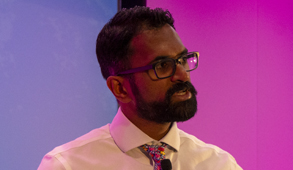Summer conference: bridge the gap to new system
While there is a lot of talk about system working currently, the focus is still on individual organisations, he said. ‘There is a disproportionate focus on providers and within that a disproportionate focus on acute hospitals. A friend in commissioning says that when they get their budget, they look at the growth and the first thing they do is sort out the acute contract.’
Competition rather than collaboration was still a driving force in the NHS, he told the HFMA summer conference today. ‘If an acute hospital moves a service into the community we must make sure it doesn't lose money. And the community provider taking on the activity and the cost pressures of that receive the commensurate income.’
He was worried about the NHS and outlined five areas of concern. These included:
- A lack of stable base for transformation – this was due to an adverse financial position, performance on access targets and low workforce morale.
- Macroeconomic issues – the uncertainty over the UK exit from the European Union was affecting the NHS in a number of ways, including delaying the spending review and the delivery of potential legislative changes.
- Funding growth is not enough – while an average of 3.4% a year is much more than received by other parts of the public sector, the funding was less than the historic average of 3.7%.
- The system architecture is in flux –the provider sector deficit had been ‘normalised’, and there were wide variations in planned and actual deficits. The long-term plan aims to see deficits eradicated by 2023/24 but he did not see this happening.
- Variation in the commitment to reform – there was a tension between ensuring financial stability of individual organisations and that of systems. ‘It’s hard to see how systems can win unless a few organisations take a hit,’ Mr Anandaciva said.
The NHS faces many difficulties, but there is cause for optimism, he said. Borrowing a quote from American football coach Vince Lombardi, Mr Anandaciva (pictured) said: ‘Hope is not a strategy’, adding that lack of plans was not a problem for the NHS. It had lots of strategies – from the long-term plan to the recently published implementation plan and interim people plan.
‘When I go around the country I see places that are further ahead – by further ahead I don't mean financially balanced and hitting performance targets. These places have a shared understanding of what they want to do, and a sense of reality about how they are going to get there and how hard it is going to be.’
The development of population-based solutions – based on neighbourhoods of around 50,000 people; places of 250,000 to 500,000 people; systems of around one million people; and regions covering 5-10 million – was also positive.
Some areas have grasped the importance of doing something, he added, such as one hospital that has opened an A&E department for patients that are aged over 80. Others have ‘reset’ their relationships, changing leadership that was ‘incompatible with system working’.
Some areas have committed to collaboration and others have brought patients into the conversation on transformation.
Related content
We are excited to bring you a fun packed Eastern Branch Conference in 2025 over three days.
This event is for those that will benefit from an overview of costing in the NHS or those new to costing and will cover why we cost and the processes.